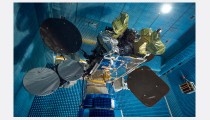
After more than 40 years of operation, DTVE is closing its doors and our website will no longer be updated daily. Thank you for all of your support.
Amos-6 satellite destroyed after launch-pad explosion
 Spacecom’s Amos-6 satellite has been destroyed following the launch-pad explosion of the SpaceX Falcon 9 rocket that was due to carry it into space.
Spacecom’s Amos-6 satellite has been destroyed following the launch-pad explosion of the SpaceX Falcon 9 rocket that was due to carry it into space.
The explosion happened at Cape Canaveral yesterday at approximately 9.07am during a standard pre-launch static fire test.
In a statement, SpaceX blamed an “anomaly” for the explosion that originated “around the upper stage oxygen tank and occurred during propellant loading of the vehicle”.
SpaceX said that it is continuing to review data to identify the root cause of the problem, and that all personnel were clear of the launch–pad and no injuries occurred.
Amos-6 was due to launch to the 4º West orbital position and provide direct-to-home (DTH), video distribution, VSAT communications and broadband Internet services.
The satellite had three Ku-Band beams to provide Middle East, Central and Eastern Europe and Pan-European coverage. It also had 36 HTS Ka-band spot beams that were due to extend over sub-Sahara Africa and Europe.
Eutelsat and Facebook were both affected by the loss of the satellite, as they had made a multi-year agreement to lease the satellite’s Ka-band payload covering Sub-Saharan Africa in order to launch broadband services there from early 2017.
Facebook CEO Mark Zuckerberg said: “I’m deeply disappointed to hear that SpaceX’s launch failure destroyed our satellite that would have provided connectivity to so many entrepreneurs and everyone else across the continent.
“Fortunately, we have developed other technologies like [solar powered plane] Aquila that will connect people as well. We remain committed to our mission of connecting everyone, and we will keep working until everyone has the opportunities this satellite would have provided.”
Eutelsat issued a statement the read: “Eutelsat remains committed to growing broadband in Africa and will explore other options to serve the needs of key clients ahead of the launch of its own full-high throughput African broadband satellite, due in 2019.”


